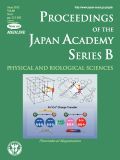巻号一覧

88 巻, 6 号
選択された号の論文の4件中1~4を表示しています
- |<
- <
- 1
- >
- >|
Reviews
-
Osamu SATO2012 年 88 巻 6 号 p. 213-225
発行日: 2012/06/11
公開日: 2012/06/11
ジャーナル フリーVarious molecular magnetic compounds whose magnetic properties can be controlled by external stimuli have been developed, including electrochemically, photochemically, and chemically tunable bulk magnets as well as a phototunable antiferromagnetic phase of single chain magnet. In addition, we present tunable paramagnetic mononuclear complexes ranging from spin crossover complexes and valence tautomeric complexes to Co complexes in which orbital angular momentum can be switched. Furthermore, we recently developed several switchable clusters and one-dimensional coordination polymers. The switching of magnetic properties can be achieved by modulating metals, ligands, and molecules/ions in the second sphere of the complexes.
(Communicated by Hiroo INOKUCHI, M.J.A.)抄録全体を表示PDF形式でダウンロード (1314K) -
Nongluk SRIWILAIJAROEN, Yasuo SUZUKI2012 年 88 巻 6 号 p. 226-249
発行日: 2012/06/11
公開日: 2012/06/11
ジャーナル フリーInfluenza virus hemagglutinin (HA) contains antigenic sites recognized by the host immune system, cleavage sites cleaved by host proteases, receptor binding sites attaching to sialyl receptors on the target cell, and fusion peptides mediating membrane fusion. Change in an amino acid(s) in these sites may affect the potential of virus infection and spread within and between hosts. Influenza viruses with H1 HA infect birds, pigs and humans and have caused two of the four pandemics in the past 100 years: 1918 pandemic that killed 21–50 million people and 2009 pandemic that caused more than 18,000 deaths. Understanding the relationship between antigenic structure and immune specificity, the receptor binding specificity in virus transmission, how the cleavage site controls pathogenicity, and how the fusion peptide causes membrane fusion for the entry of influenza virus into the host cell should provide information to find more effective ways to prevent and control influenza.
(Communicated by Hiroshi KIDA, M.J.A.)抄録全体を表示PDF形式でダウンロード (1982K) -
Nobuyuki SHIBATA, Hidemitsu KOBAYASHI, Shigeo SUZUKI2012 年 88 巻 6 号 p. 250-265
発行日: 2012/06/11
公開日: 2012/06/11
ジャーナル フリーThis review describes recent findings based on structural and immunochemical analyses of the cell wall mannan of Candida albicans, and other medically important Candida species. Mannan has been shown to consist of α-1,2-, α-1,3-, α-1,6-, and β-1,2-linked mannopyranose units with few phosphate groups. Each Candida species has a unique mannan structure biosynthesized by sequential collaboration between species-specific mannosyltransferases. In particular, the β-1,2-linked mannose units have been shown to comprise a characteristic oligomannosyl side chain that is strongly antigenic. For these pathogenic Candida species, cell-surface mannan was also found to participate in the adhesion to the epithelial cells, recognition by innate immune receptors and development of pathogenicity. Therefore, clarification of the precise chemical structure of Candida mannan is indispensable for understanding the mechanism of pathogenicity, and for development of new antifungal drugs and immunotherapeutic procedures.
(Communicated by Takao SEKIYA, M.J.A.)抄録全体を表示PDF形式でダウンロード (1051K) -
Susumu ANDO2012 年 88 巻 6 号 p. 266-282
発行日: 2012/06/11
公開日: 2012/06/11
ジャーナル フリーThe author focused on the functional decline of synapses in the brain with aging to understand the underlying mechanisms and to ameliorate the deficits. The first attempt was to unravel the neuronal functions of gangliosides so that gangliosides could be used for enhancing synaptic activity. The second attempt was to elicit the neuronal plasticity in aged animals through enriched environmental stimulation and nutritional intervention. Environmental stimuli were revealed neurochemically and morphologically to develop synapses leading to enhanced cognitive function. Dietary restriction as a nutritional intervention restored the altered metabolism of neuronal membranes with aging, providing a possible explanation for the longevity effect of dietary restriction. These results obtained with aging and dementia models of animals would benefit aged people.
(Communicated by Kunihiko Suzuki, M.J.A.)抄録全体を表示PDF形式でダウンロード (650K)
- |<
- <
- 1
- >
- >|